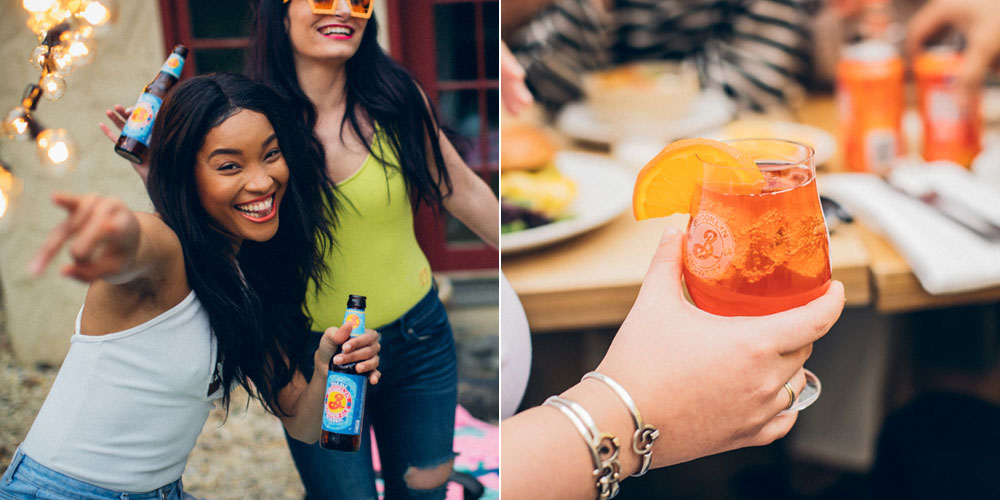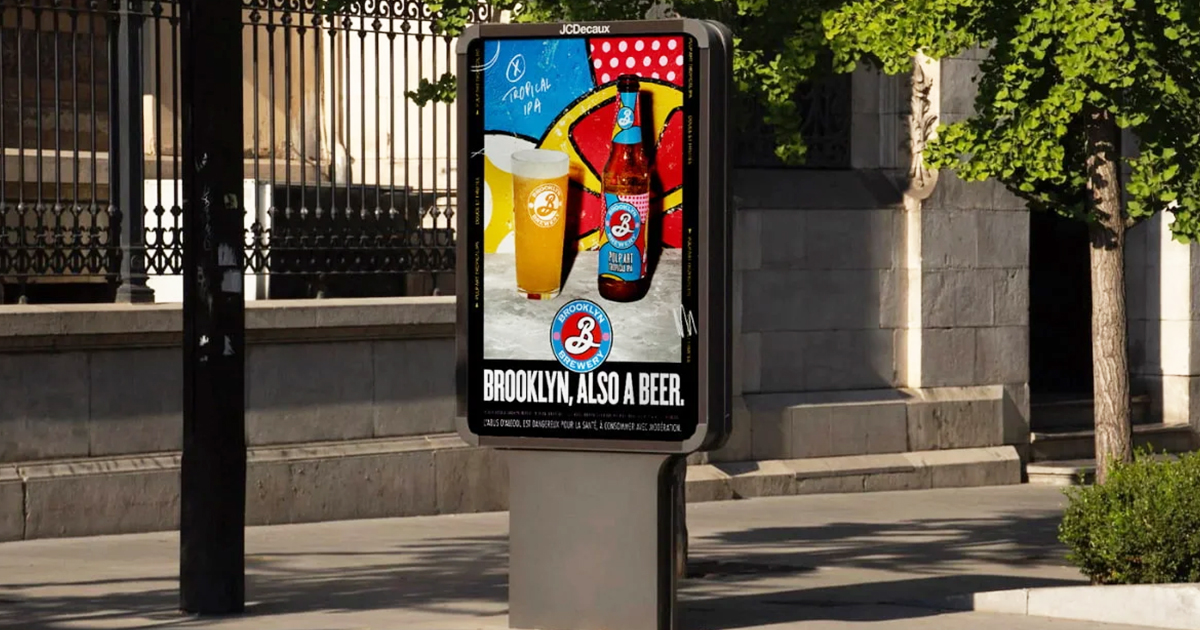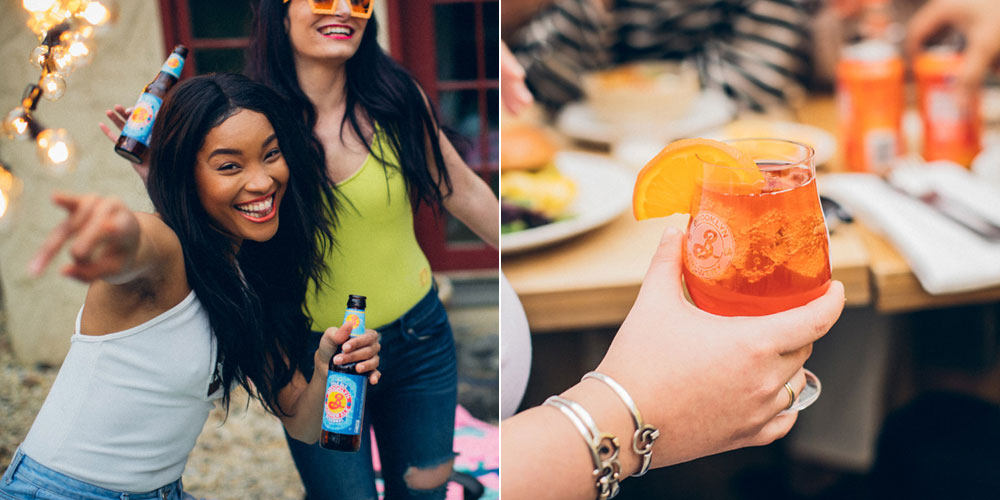A perfect sunny day at the beach. A relaxing weekend barbecue. A rollerskating session with friends after a long day at work. In each of these scenarios, beer cans and bottles aren’t far from reach. Smiling people pour themselves a beer and toast with their friends. These pictures made by photographer Roberto Chamorro for Brooklyn Brewery portray some of these moments while promoting the brewery’s brand in the United States.

In contrast, the image below: a simple pint and bottle on a concrete surface with a colorful background mimicking the label. On the bottom, the phrase “Alcohol abuse is bad for your health” is part of the message. This is also an advertisement for Brooklyn Brewery, but this one was made for the French market. If the brewery had released the joyful pictures at the beach, they could have received a fine for being non-compliant with the country’s Évin law, which restricts the way alcohol (and tobacco) producers can communicate about their products since 1991. Among other things, the law prohibits the association of alcohol with pleasure or sport in ad campaigns.

Luckily, Brooklyn Brewery has a French team (Brasseries Kronenbourg, owned by the Carlsberg Group, distributes their beer in France) that knows all about the do’s and don’ts of the Évin law and how to keep legislators satisfied.
But not everyone has the budget to have brand managers in several countries or to open breweries abroad—like Colorado-based Outer Range did in the French Alps in 2023—to facilitate exporting beer.
“Selling beer here in Virginia requires us to have marketing out there, to get people to understand our brands, to understand what we’re doing and what we’re making, and it’s so much harder to do that in a foreign market,” says Chris Smith, co-founder of The Virginia Beer Company in Williamsburg. The brewery exports to the U.K., Sweden, and the Netherlands.
For breweries wanting to export and market their beers overseas, dealing with the different European laws and regulations can be tricky. Surprisingly, other aspects of the beer export process go smoother than expected.
A Price To Pay
In 2022, 7.3% of U.S. craft beer exports were to the U.K., 7.1% to Sweden, and 5.2% to the Netherlands—followed by Italy, Ireland, and France. Those top three markets are also the main European markets for Qurban Walia, co-founder of Crafted Exports, an export and brand management company based in New York.
While Walia says breweries’ main concerns when reaching out to him are sales, growth, and the freshness of their beer, he’s looking at a bigger picture. “We have to understand what’s going on in the U.S. with all the breweries and what they’re [European markets] looking for,” he says. “But we also have to understand what’s going on in every international country that we sell to, and what’s happening in their beer market as well.”
With currency fluctuations and the U.S. dollar being stronger compared to most European currencies, pricing is also tough to navigate.
“Usually breweries sell at a lower price for international markets to try and offset the price of additional shipping costs, increased taxes, and then the currency,” Walia says. “It can sometimes seem like U.S. beer is very expensive, but it’s just because that’s the cost of getting it from here to there.”
Smith agrees. “If we sold [our beers] at our U.S. pricing, no one would buy it,” he says. “We try to make the beer as affordable as possible on the shelf to give it a chance, but that puts pressure on us and on our margin.”
And The Winner Is
Another potential headache is compliancy with labeling legislations. In the European Union, there are some shared rules regarding alcohol labeling laws: mentioning the ingredients is not mandatory, nor is listing the calorie content for beverages above 1.2% ABV.
Some countries have exceptions, though: in France, the pregnancy warning pictogram size—which must be represented on every label, domestic or imported—is regulated. In Ireland, by 2026, alcohol products will have to mention the health risks associated with alcohol consumption on the label and anyone exporting will also have to comply.
“We work mostly with the breweries to update their designs, to make sure that they’re compliant with the specific country,” Walia says. Depending on the size of the order and the country the beer is sent to, compliance can range from applying stickers to doing custom cans or changing the whole label. And one important market for U.S. breweries is very specific on what it wants and doesn’t want: Sweden.
As in Norway with Vinmonopolet and Finland with Alko, Sweden has its own government-owned alcoholic beverage retailer for beverages above 3.5% ABV (4.75% in Norway and 8% in Finland): Systembolaget. Labels connecting alcohol with work, children, sports, weapons, traffic, or sexuality are strictly prohibited, which has led some breweries to redo their artwork. For example, the little hop character on the can of Captain Lawrence Brewing Co’s Effortless Grapefruit IPA had to lose its knife to make it on their shelves.
But before even being listed in a Systembolaget, breweries have to enter and win tenders categorized by beer styles. After entering three, Virginia Beer Company won the Summer IPA tender and started exporting in 2025. “The process is a little bit tough, but because we came in second place in that tender, our importer could pitch directly to Systembolaget for some additional beers,” Smith says. “We shipped a 40-foot container.”
Despite those rigorous rules, Walia says the Swedish market is one of his favorite ones to work with, and the tenders and blind taste test are part of the reason why. “They’re judging the beer, not how big your marketing budget is, but on the quality of the liquid, the quality of the beer,” he says. “That’s why there’s such an explosion of craft beer in the Scandinavian markets, because they’ve made taste the priority, not price.”
On The Bright Side
Breweries would not go through the trouble of shipping beer overseas if there weren’t a positive side to it. Against all odds, administrative procedures can be one of them.
“Even though it’s more expensive to ship beer to Europe because of the taxes, the governments do a really good job of making it very easy to work with the compliance and actually getting the beer through customs,” Walia says.
The compliance breweries have to deal with on a daily basis when selling their beer domestically is mostly taken care of by the exporters and importers, which is a relief in itself. “We’re asked why we don’t sell beer in some of our neighboring states, and it’s because we literally have to register it in every single state,” Smith says. “It’s easier for us to sell beer in France in so many ways, which is kind of ridiculous.”
Smith also says he was surprised to see how similar the European market was in terms of people’s tastes, listing “hazy IPAs, barrel aged stouts, and heavily fruited sours with a bunch of stuff in them” as a shared preference amongst beer drinkers. “I expected consumers to have different preferences than American consumers.”
While there’s a growing interest for craft lagers in the States, European consumers are still craving the haze. “All styles have done very well for us, but lagers tend to be a bit of a challenge, partly because Europe has so many great and very affordable lagers,” Walia says. “When people think about the U.S., they’re really looking for IPAs, whether they’re hazy IPAs or West Coast IPAs.”
New Concerns
Because of that strong lager heritage and low pricing, some markets such as Germany or Czech Republic still feel out of reach for U.S. breweries. Others that are more focused on bottles such as Italy or France have opened up, but with rising competition.
“The beer has gotten so good in countries like France that I think there are fewer people willing to pay the premium for American craft beer than there used to be,” said Smith, who used to export to France before his importer stopped doing business. “The number of importers has also decreased in a lot of these countries, so it’s become more challenging.”
While he has hopes of getting back to business in France and adding Italy to the list, it will have to wait. “Geopolitical issues right now have made it nearly impossible,” he says in reference to the Trump administration’s trade wars that are bringing questions and uncertainty.
At Crafted Exports, Walia has to deal with these new concerns from brewers. “I get a lot of calls from brewers who are trying to understand the tariffs,” he says. “They want to know how things are working from a political standpoint globally, and how that impacts international trade.”
In spite of this unpredictable situation, breweries, importers, and exporters still pursue collaboration. After a successful experience in Sweden in 2024, in 2025 Walia organized a road show to the U.K. with breweries he’s representing.
“[We brought] our beers there so that they can meet people from the brewery and understand American beer,” he says. “But also so the breweries can better understand the market and what they need to do to be successful in it.”
The post Across the Atlantic: How U.S. Breweries Navigate the European Market appeared first on CraftBeer.com.
